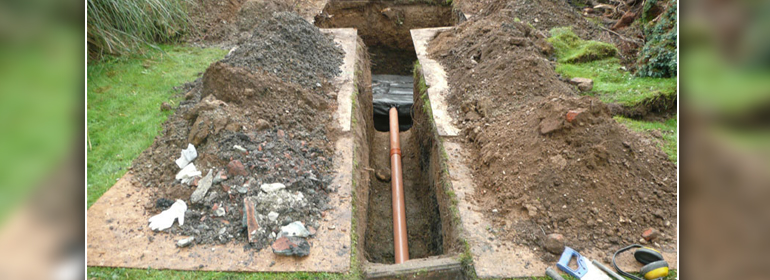We all love to save money, especially on regular, outgoing expenses. If you aim to reduce your utility bills, most people think of changing energy supplier or cutting energy usage. But one lesser known way is to reduce your water bill by slashing your surface water drainage charges. One way this can be done is with a soakaway construction.
This short article explains what we mean by the terms ‘surface water’ and a ‘soakaway’, and how a construction could reduce your water bills. Firstly, surface water is water which falls as rain and is collected by the gullies and drains throughout your property. In the majority of cases, the rainwater which is not absorbed by the ground runs off into an alternative drainage system, such as a public sewer. Otherwise, your land would be permanently flooded. Your local water company imposes a charge if you take advantage of a public sewer they maintain to dispose of excess water on your property. However, you may be paying this fee unnecessarily if your excess water is not entering that public sewer. So what is a soakaway and what effect does it have on surface water? In the simplest of terms, a soakaway drainage system consists of a hole that has been dug in the ground and filled with coarse stone and rubble. This allows for the percolation of surface water back into the earth close to where it falls. In order for you to be able to claim a rebate on your bills from your local water company, though, all of the rainwater from your home must drain away via the soakaway and/ or drainage solutions other than the public sewer.
This might include scenarios where all surface water runs off directly into a nearby river, stream or brook. To determine whether you’re eligible for a reduction in your water bill, you must usually apply to your company, enclosing a diagram of where you think your surface water drains to. They may come and inspect the site to check the details. If it can be proven that you do not utilise the company-maintained sewer connection in any way, then you may be entitled to a refund of the proportion of bills you have paid them in the past, as well as a rebate on future bills. Remember, to benefit from this, no rainwater at all must end up in the public sewer – this includes rain that falls to the front and rear of your property; as well as water which falls on your roof, patio, driveway, garden or yard. The picture alters for businesses and the like, though. If you are a non-household customer, you may find that you are charged for surface water drainage by site area.
In this case, it may be possible to reduce your bills for removal of surface water by other methods such as soakaway construction and altering your property so that impermeable areas such as a carpark are permeable, to promote natural drainage. If you’d like to cut your water bills, it’s well worth checking your options with Ofwat, the economic regulator for water in England and Wales.

